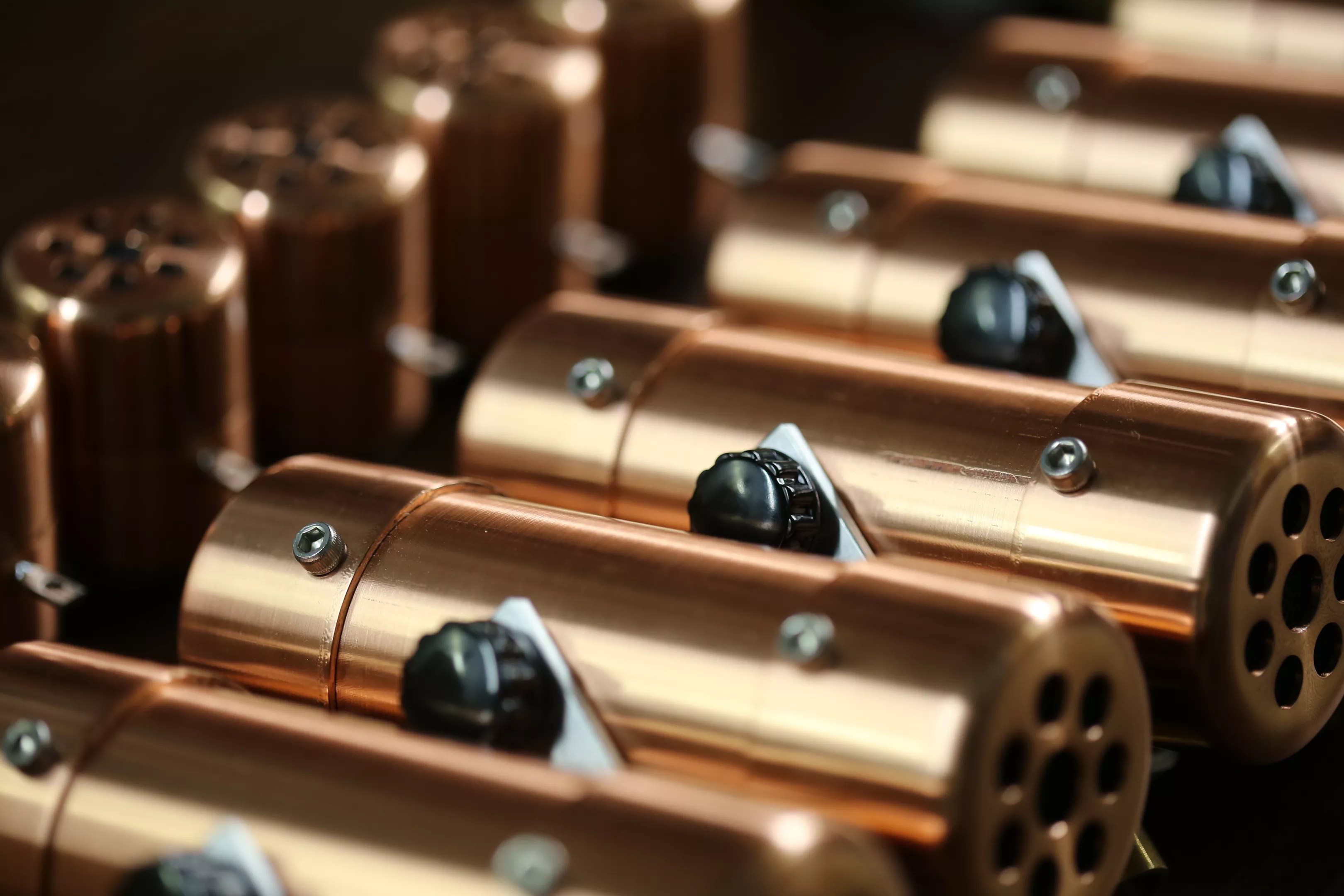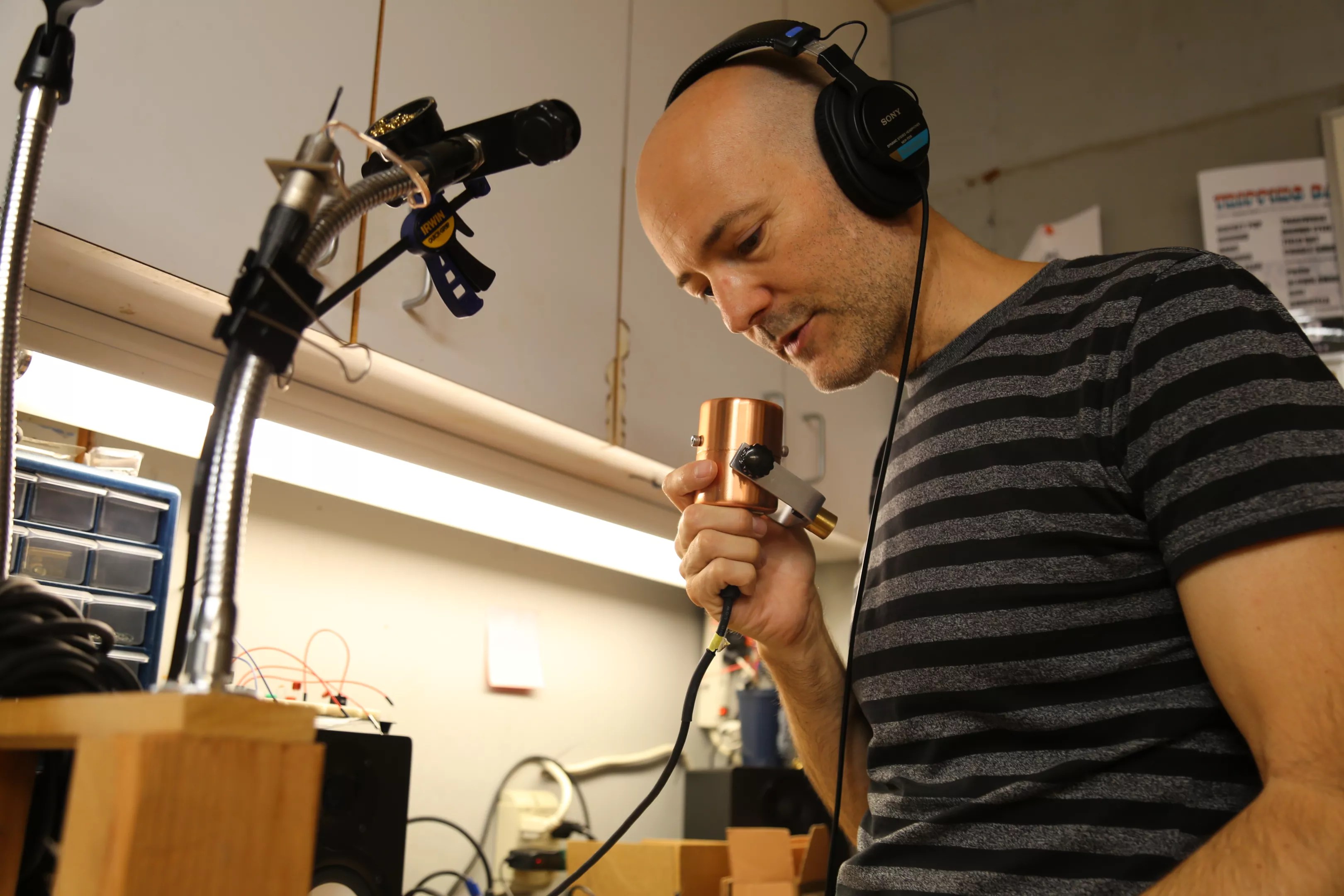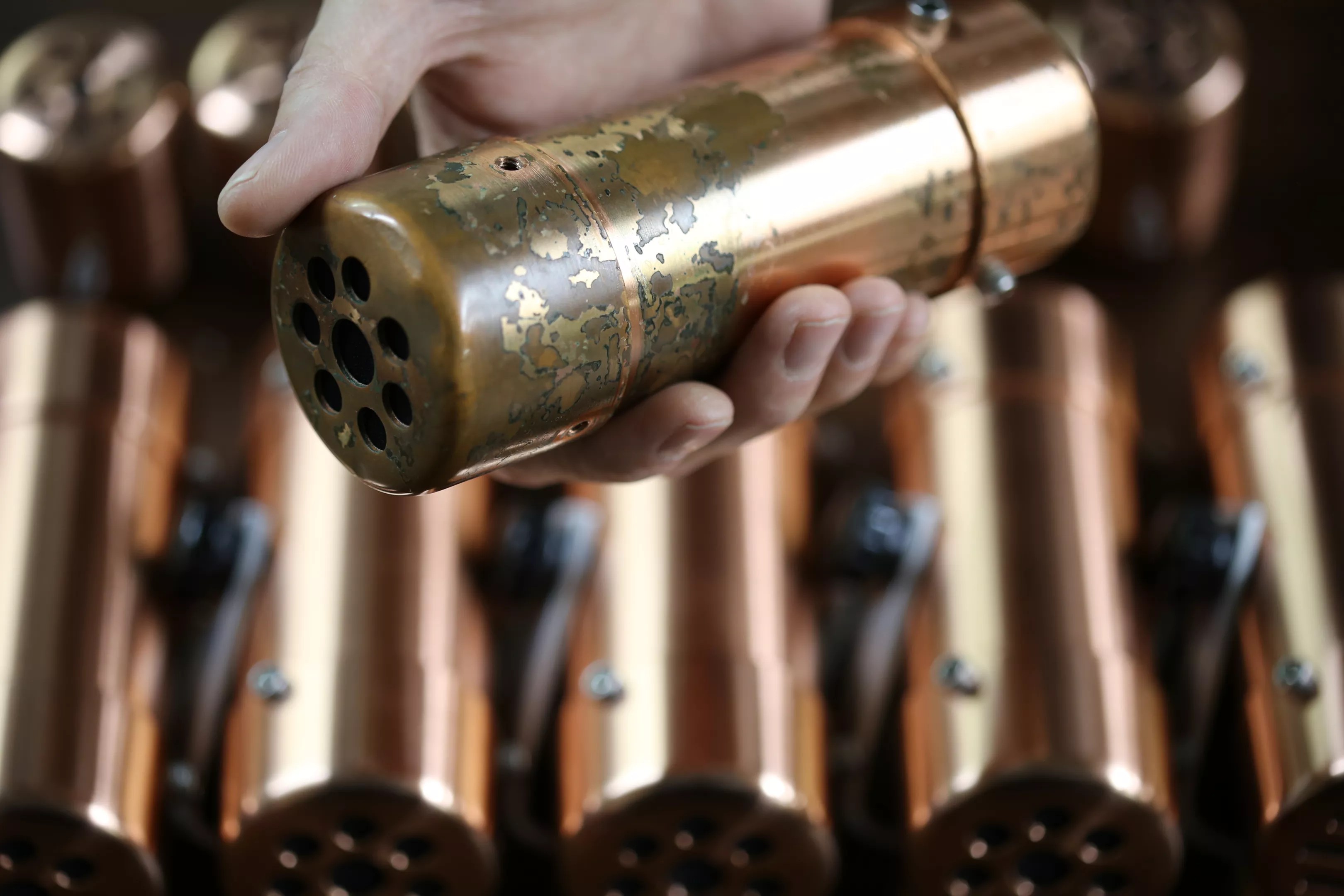
Daniel Rodrigue

Audio By Carbonatix
“Mic check. Test one, two. Check one, two.”
Mark Pirro’s voice squawks to life from the speakers at a workstation inside the workshop and factory where he designs, produces and distributes small-batch microphones. In the East Dallas building that serves as the home of Placid Audio, he and a handful of part-time employees assemble by hand the attention-grabbing copper microphones for which his company is known.
With a pair of headphones over his ears, Pirro holds a small copper mic in one hand while slowly twisting a knob on a mixer. “Check. Check,” his voice reverberates off the walls, sounding like a store’s public address system. He’s testing out the soon-to-be-released Carbonphone RU80, a newly designed microphone that utilizes decommissioned Cold War-era Soviet military components.
Since Pirro assembled his first mic in 2001, each of Placid Audio’s distinctive microphones has used components from vintage communications equipment paired with a mechanical filtering device to generate a limited bandwidth frequency response that, to the listener, sounds similar to an AM radio broadcast and calls to mind nostalgic lo-fi sounds from the early days of broadcast and recording technology.
Placid’s microphones also come housed in polished copper-body tubes that seem to change color from a light pink-brown to a darker reddish-brown depending on the type of light falling on the cylindrical tubes.

Mark Pirro made the first Copperphone for Tim DeLaughter, and when the Polyphonic Spree began touring internationally, the other bands who heard the band play began asking for microphones.
Daniel Rodrigue
The instantly recognizable copper mics quickly developed a cultlike following among producers looking to re-create a vintage sound, as well as bands in need of road-worthy mics that look equally gorgeous on a stage and in a recording studio.
Pirro designed the first Copperphone while playing bass with The Polyphonic Spree as a way to produce a “telephone-sounding” voice effect for lead singer Tim DeLaughter. Placid Audio’s mics have been used by many engineers, studios and performing artists, including Beck, Erykah Badu, Norah Jones, Snoop Dogg, Sam Smith, Jack White (Raconteurs, The White Stripes), Annie Clark (St. Vincent), Peter Buck (REM), Dan Auerbach (The Black Keys), Johnny Marr (The Smiths, The The, Modest Mouse), Jim Heath (The Reverend Horton Heat), Rivers Cuomo (Weezer) and Grammy-winning producer Jacquire King.
But on the way from turning a one-at-a-time microphone process into full-time business, Pirro faced hurdles ranging from shortages of critical parts to the skyrocketing cost of copper. And a microphone made the news once after shutting down part of a terminal at D/FW International Airport.
Placid Audio produces a line of five microphones, and while all the microphones deliver something a little different, each is designed to impart an obvious character on the signal that could be used as a standalone effect on vocals or an instrument, or as a blend mic to add subtle character to more traditional mics. And Placid Audio’s mics frequently receive glowing reviews in industry magazines — including Recording Magazine, Mix Magazine, Electronic Musician Magazine and Tape Op Magazine — for their sound characteristics and creative possibilities. The microphones are so sleek and eye-catching that, like a popular supermodel in a fashion magazine, they’ve landed on the cover of Recording Magazine at least four times in the past decade.
But how did Pirro transition from bass player in Tripping Daisy and Polyphonic Spree to the owner of a successful small-batch audio company?
“I made the first Copperphone right around the time the Spree started,” Pirro says. “It was more of, you know the saying: ‘Necessity is the mother of invention.’ It really was trying to solve a problem. Tim used this AM radio effect from a rack processor, called an SPX 990. It was great. It had an incredible sound, and in the studio it was perfect. But in a live setting it didn’t work as well. And I just thought it would be better if there was a microphone that just did that and looked cool and was functional and rugged and all these other things.”

Each of Tim DeLaughter’s Copperphones develops its own patina.
Daniel Rodrigue
Once he mocked up a working prototype out of PVC, duct tape and other components, he had to find a way to install it in something that was road-worthy for touring acts working in a professional, demanding environment. After a few trips to “every hardware store” in the area, Pirro says, he settled on copper because of “its beautiful color and the fact that, at the time, copper was inexpensive.”
In the early 2000s, the price for a pound of copper had dipped to low prices that hadn’t been seen since the early ’80s. Then, around the summer of 2003, the price started to climb and doubled from 67 cents to $1.30 by 2004. By 2006, the price skyrocketed to $4.01.
“It was irritating because every time I went to go buy copper … the price kept going up. And I was shopping around, and then someone finally told me there was a world demand on copper,” Pirro says. “Thankfully, the price has finally leveled out.”
Another reason he went with copper for his lifetime-guaranteed mics is that the copper will develop a patina over time, which adds another level of uniqueness and character to each mic.
“There are different ways to get patinas. Let me show you something,” Pirro says, disappearing into a back corner near a table covered with polished copper tubes and half-assembled microphones. As he walks to the back, his voice trails off as he says, “I’ll show you the first Copperphone … .”
He emerges holding a well-worn mic with a few dents and a charming patina. He built it in 2001.
“This is kind of dismantled, but this is what one looks like when the mics develop a natural patina. It used to belong to Tim. But I gave him a new one because we were doing so much touring and stuff with it, and I wanted his to look presentable.” As he turns the nearly 2-pound microphone over in his hand, revealing deeper discoloration on the other side, he explains that the oils from an owner’s hand, as well as saliva and sweat, will interact with the protective finish and then the copper itself.
“That’s kind of how they’ll age, and that’s all from him grabbing it like this,” he says, gripping the mic like a charismatic frontman.
In the early days, Pirro says, he built the mics in a 6-by-6-foot space in his parents’ “sweaty garage” because, at the time, he lived in an apartment and the mics were nothing more than a supplement to his income. Now, 17 years later, Placid Audio has become Pirro’s full-time gig, and he and a handful of part-time employees assemble Placid Audio’s microphones at a small, air-conditioned, well-lit factory in East Dallas. And over the past five years, he’s streamlined his production line and ramped up production.
But Pirro is quick to explain that the success of Placid Audio has a lot to do with the success of Polyphonic Spree. As part of the 20- to 25-member orchestral-choral, pop-rock group, he toured internationally throughout the United States, Europe, Japan, Australia and Canada.
“They are like a functioning art piece in my mind,” says Chris Penn of Good Records and Good Pagoda. “I’d want to have them at any store that I ever have.”
“The Spree did the same thing Tripping Daisy did,” he says. “It just took off. And people said we’d never get the band out of Texas, but the first time we went out of town was to England to play David Bowie’s Meltdown Festival. And from that time on, the Spree just skyrocketed, and it kind of dovetailed into the success of Placid Audio because Tim was using the microphone, and we were playing big festivals, and some of the top bands at the time, and people in the audience were seeing the mic and hearing it.”
During the Spree’s tours, other bands and engineers heard the sound delivered by the eye-catching copper microphone and asked about it. At first, Pirro says, he hadn’t even considered selling them.
“I wasn’t selling them initially. First for Tim to have, then people started asking about them, and there was a demand. It didn’t dawn on me for a few months that I could even sell them. Then, I realized there was an interest there. But I didn’t have any to sell. So I figured the next time someone asked me, I could say, “I can make you one.” And that’s what I did.”
The initial requests were from people in other bands and people he met while on tour who approached him after shows. He’d take down their names and emails and then make them microphones after the tour. Soon, word spread among engineers and bands like ripples of a sound wave, and with the Copperphone’s reputation for durability and distinct sound, orders started to stack up.
After making them one at a time for a while, he started making 10 at a time, then 20 or 30, and finally, thanks to the economy of scale, 50 to 100 at a time. Now, depending on demand, he and his crew assemble and ship a few hundred microphones a year through Placid Audio’s website and a few retail locations
Two locations (with ties to Tripping Daisy and Polyphonic Spree) stock the microphones locally.
“We usually carry one of each mic, as his stock level permits,” says Chris Penn of Good Records and Good Pagoda. In addition to managing Good Records, Penn manages The Polyphonic Spree and Tripping Daisy, and he says even if he hadn’t known Pirro for nearly two decades, he would still want to carry the mics.
“They are like a functioning art piece in my mind,” he says in between helping customers at Good Records. “I’d want to have them at any store that I ever have. They really are beautiful and are one of a kind. He made the first one for Tim. And now Jack White has one. And Wayne [Coyne] from Flaming Lips has one. And Jason [Lytle] from Grandaddy. And it’s now in tons of studios.”
Now that Placid’s copper mics have caught on, what’s next for Pirro, other than introducing the RU80?
“I have tons of other ideas that I hope to get to one day,” he says, “literally a stack of ideas that I’ve jotted down. And things I can see in my head that I can visualize and that I know exactly how they will go together. People dream of having their own business and being in full control of it and being able to navigate it where they want it to go. And I’m going to hold on to this for as long as I can.”